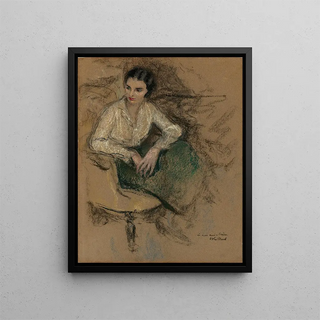Art print | Portrait of Irène Montanet (Case Conflict) - Édouard Vuillard


View from behind

Frame (optional)
In the world of art, some works transcend the simple frame of painting to become silent witnesses of their era. The "Art print of Irène Montanet (Cas Conflict)" by Édouard Vuillard is one of those creations that capture the essence of a personality while evoking an intimate and reflective atmosphere. This portrait, with its delicate palette and subtle nuances, invites the viewer to delve into the inner universe of its subject. Vuillard, an iconic figure of the Nabi movement, manages to infuse this work with a psychological depth that still resonates today.
Style and uniqueness of the work
Vuillard's style is immediately recognizable thanks to his bold use of color and texture. In the "Art print of Irène Montanet," he plays with color planes that harmoniously overlay, creating an atmosphere that is both warm and mysterious. The details of Irène's face are rendered with remarkable delicacy, while the background, often decorated with floral or geometric motifs, adds an extra dimension to the composition. The way Vuillard captures light and shadow on his model's face demonstrates his skill in translating emotions through color. This art print does not merely depict a person; it evokes an ambiance, a story, a connection that goes beyond the mere visual.
The artist and his influence
Édouard Vuillard, born in 1868, is one of the leading representatives of the Nabi, an artistic movement advocating a more personal and symbolic approach to art. Influenced by the innovations of his time, Vuillard was able to create a unique style that blends intimacy and modernity. His works, often centered on scenes of everyday life, reveal a particular sensitivity to human relationships and interior spaces. The "Art print of Irène Montanet" exemplifies this approach, as it does not limit itself to the physical representation of his model but also explores the emotions and social dynamics surrounding her. Vuillard's influence extends far beyond his era, inspiring many contemporary artists to explore

Matte finish

View from behind

Frame (optional)
In the world of art, some works transcend the simple frame of painting to become silent witnesses of their era. The "Art print of Irène Montanet (Cas Conflict)" by Édouard Vuillard is one of those creations that capture the essence of a personality while evoking an intimate and reflective atmosphere. This portrait, with its delicate palette and subtle nuances, invites the viewer to delve into the inner universe of its subject. Vuillard, an iconic figure of the Nabi movement, manages to infuse this work with a psychological depth that still resonates today.
Style and uniqueness of the work
Vuillard's style is immediately recognizable thanks to his bold use of color and texture. In the "Art print of Irène Montanet," he plays with color planes that harmoniously overlay, creating an atmosphere that is both warm and mysterious. The details of Irène's face are rendered with remarkable delicacy, while the background, often decorated with floral or geometric motifs, adds an extra dimension to the composition. The way Vuillard captures light and shadow on his model's face demonstrates his skill in translating emotions through color. This art print does not merely depict a person; it evokes an ambiance, a story, a connection that goes beyond the mere visual.
The artist and his influence
Édouard Vuillard, born in 1868, is one of the leading representatives of the Nabi, an artistic movement advocating a more personal and symbolic approach to art. Influenced by the innovations of his time, Vuillard was able to create a unique style that blends intimacy and modernity. His works, often centered on scenes of everyday life, reveal a particular sensitivity to human relationships and interior spaces. The "Art print of Irène Montanet" exemplifies this approach, as it does not limit itself to the physical representation of his model but also explores the emotions and social dynamics surrounding her. Vuillard's influence extends far beyond his era, inspiring many contemporary artists to explore






